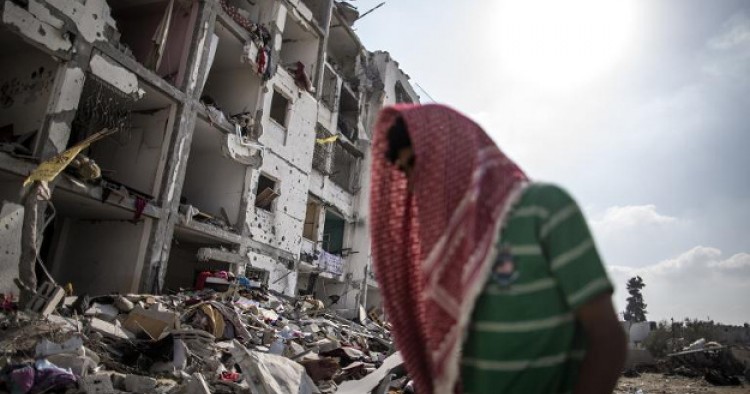The terrible war in Gaza, the third and worst of its kind in the last decade, is a product of Palestinian political disarray, Arab disunity, and division in Israel. Washington’s policy of “no direct talks” with Hamas and bitter partisanship between the White House and Congress have also limited effective U.S. intervention. As such, this latest tragedy is yet another symptom of decades of failure to resolve the larger Israel-Palestine conflict, which, without major policy changes, will surely drag on regardless of the latest cease-fire.
Both Israel and Hamas plunged into the war without clear strategies, resulting in a spiraling cost in destroyed Palestinian civilian lives, property, and infrastructure, including hospitals, mosques, and seven UN schools used to shelter displaced civilians. Israelis too have paid a high price with over 60 soldiers and three civilians killed and the trauma of a shower of increasingly sophisticated missiles. Yet until Monday, both sides had rejected multiple international cease-fire attempts brokered by Egypt, Qatar, Turkey, and U.S. Secretary of State John Kerry.
After almost a month of violent stalemate, Israel had begun redeploying forces across the border, but the rising number of civilian casualties from its air and artillery attacks incurred international outrage. Israel's claims that its air and artillery strikes are precisely targeted to avoid civilian casualties appear disingenuous. For their part, Hamas leaders have been callous in prolonging missile fire—long after scoring points in the early days of the war—at great cost and suffering for the civilians who have paid the price of war. Netanyahu has said that Israel will continue to do what it must for its security, saying Israel will yield only if there is “quiet for quiet.”
Whether or not the current deal holds, some kind of prolonged cease-fire is inevitable as both sides have exhausted themselves. Both will claim victory, but there truly are no winners in the ruins of Gaza.
Both sides will claim victory, but truly there are no winners in the ruins of Gaza.
To date, the war has killed more than 1,800 Gazans, mostly civilians, including many women and children, and the chaos and carnage have created a humanitarian disaster. Israel has achieved no strategic gains by pulverizing major urban areas of Gaza with indiscriminate bombing and artillery strikes. On the contrary, it has harmed Israel’s reputation and outraged international partners and the United Nations, while isolating its sole supporter, the United States. Perhaps the highest cost is that its doctrine of seeking security through deterrence by force, rather than diplomacy, is threadbare.
The impact of the war on Hamas is more difficult to gauge. The war has revealed the depths of division among its erstwhile supporters in the region. Turkey and Qatar continue to back the Hamas militia while Egypt, Saudi Arabia, the UAE, and Jordan are unwilling to support the group with Muslim Brotherhood origins. At the very least Hamas remains standing and, by seizing the banner of resistance while PLO President Mahmoud Abbas was left on the sidelines, it has reversed a decline in support from Palestinians, at least for the moment.
Preventing further wars in Gaza will require meeting both sides’ legitimate grievances. This means eliminating Hamas’ missiles that terrorize Israelis and ending Israel’s land, air, and sea blockade of Gaza, which has ruined the small territory’s economy and caused great hardship for the people. Without resolving these grievances, any cease-fire will only be an intermission before the next war.
But such a logical trade-off is unlikely without a broader Israel-Palestine peace, a prospect now even more distant. Nevertheless, Israeli, American, and Palestinian leaders would be wise to treat the current war as a catalyst for radical policy changes. A new policy scenario for peace, using Gaza as a starting point, would require a level of leadership and vision currently lacking. Without it, the conflict will continue to fester and intermittently explode.
For Hamas, a viable new approach to peace would include recognition of Israel’s right to exist and ending the threat of violence by dismantling its missiles and integrating its fighters into a united Palestinian security force. Both Hamas and the PLO would commit to free, democratic elections.
For Israel, a new approach would require commitment to a genuine unified Palestinian state in the West Bank and Gaza based on the 1967 lines, along with genuine negotiations anticipating compromises on all final status issues. It would also reverse Israel’s policies of opposing Palestinian statehood through settlements and its “divide and conquer” strategy enforced by blockading Gaza. Recognition of the new Palestinian unity government and support for participation of all parties, including Hamas, in peaceful politics would also be part of a transformed Israeli policy.
For the United States a fresh start would require a new peace initiative in the form of a comprehensive American plan as the basis for renewed peace talks, as well as the determination to press forward with the talks as a key priority. The goal would be to establish two sovereign states along the 1967 lines. The United States should also offer strong political and material support to a legitimately elected Palestinian unity government, and end its dysfunctional policy of refusing contact with Hamas. The need for strong American leadership and policies that will bring change and renew hope are urgent.
Obviously, given the political realities, such transformative policies by all parties, including the United States, are not achievable today. But governments change, policies are volatile, and strong leaders can help change public opinion and create new realities that support peace. Planning for this should begin now.
(Photo: AFP)
The Middle East Institute (MEI) is an independent, non-partisan, non-for-profit, educational organization. It does not engage in advocacy and its scholars’ opinions are their own. MEI welcomes financial donations, but retains sole editorial control over its work and its publications reflect only the authors’ views. For a listing of MEI donors, please click here.













